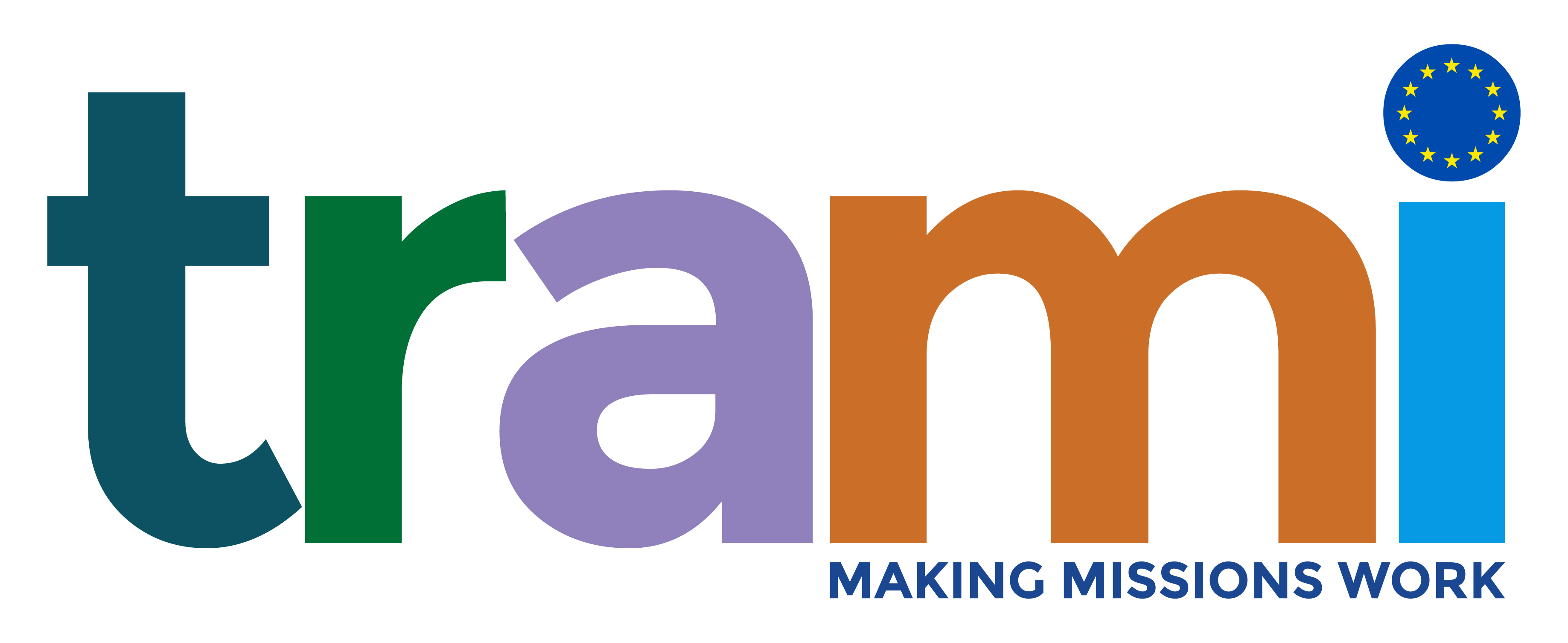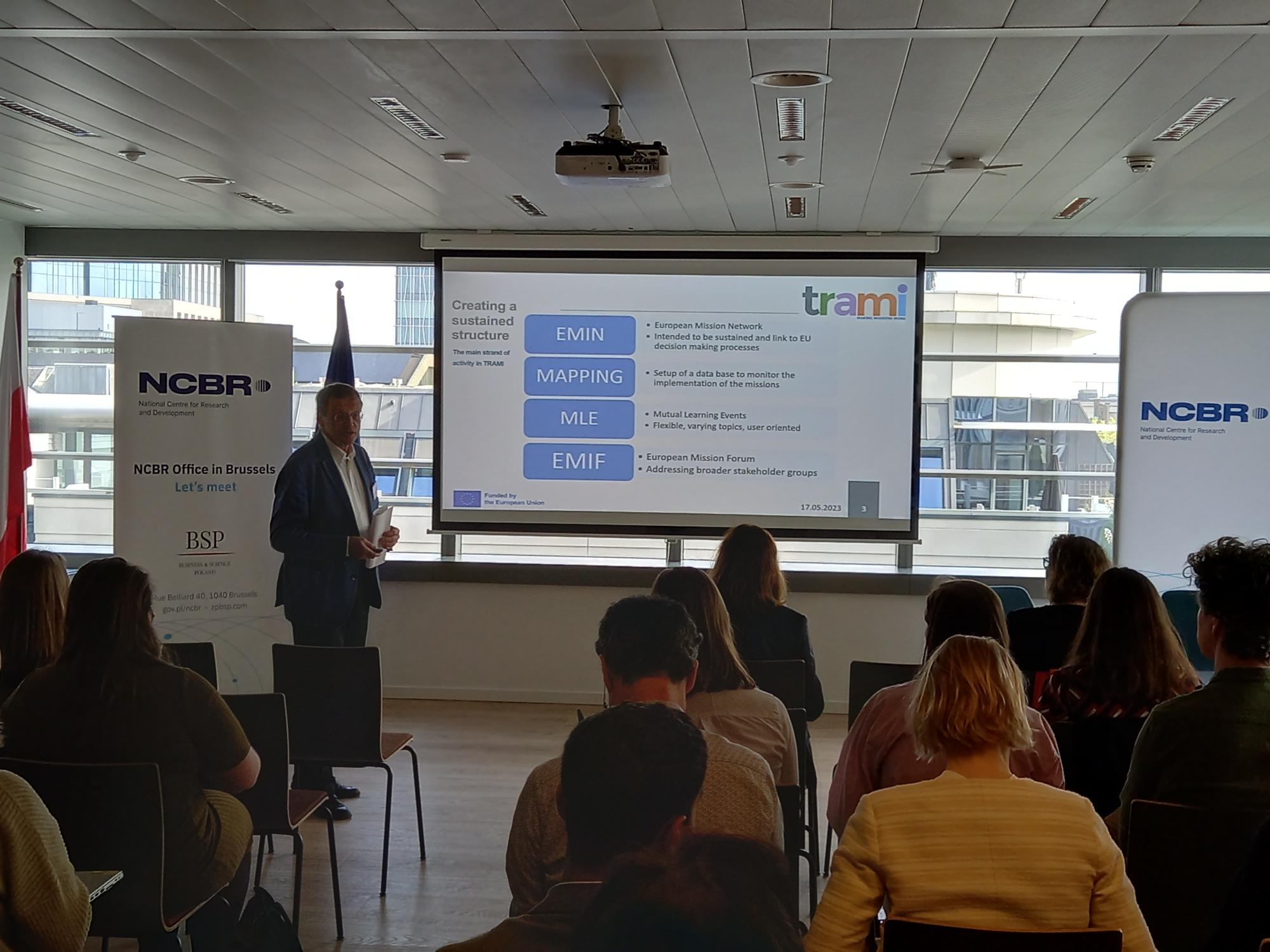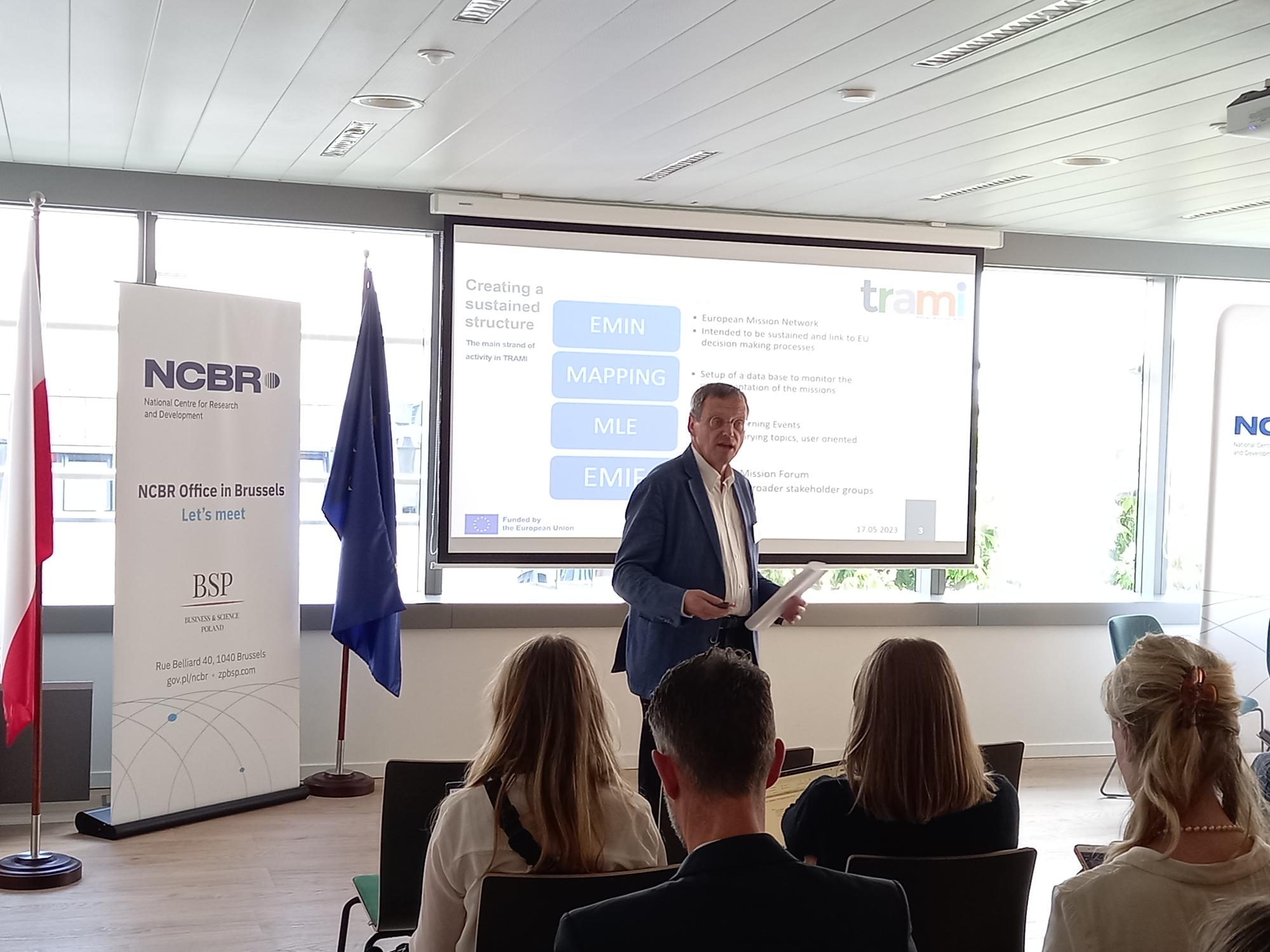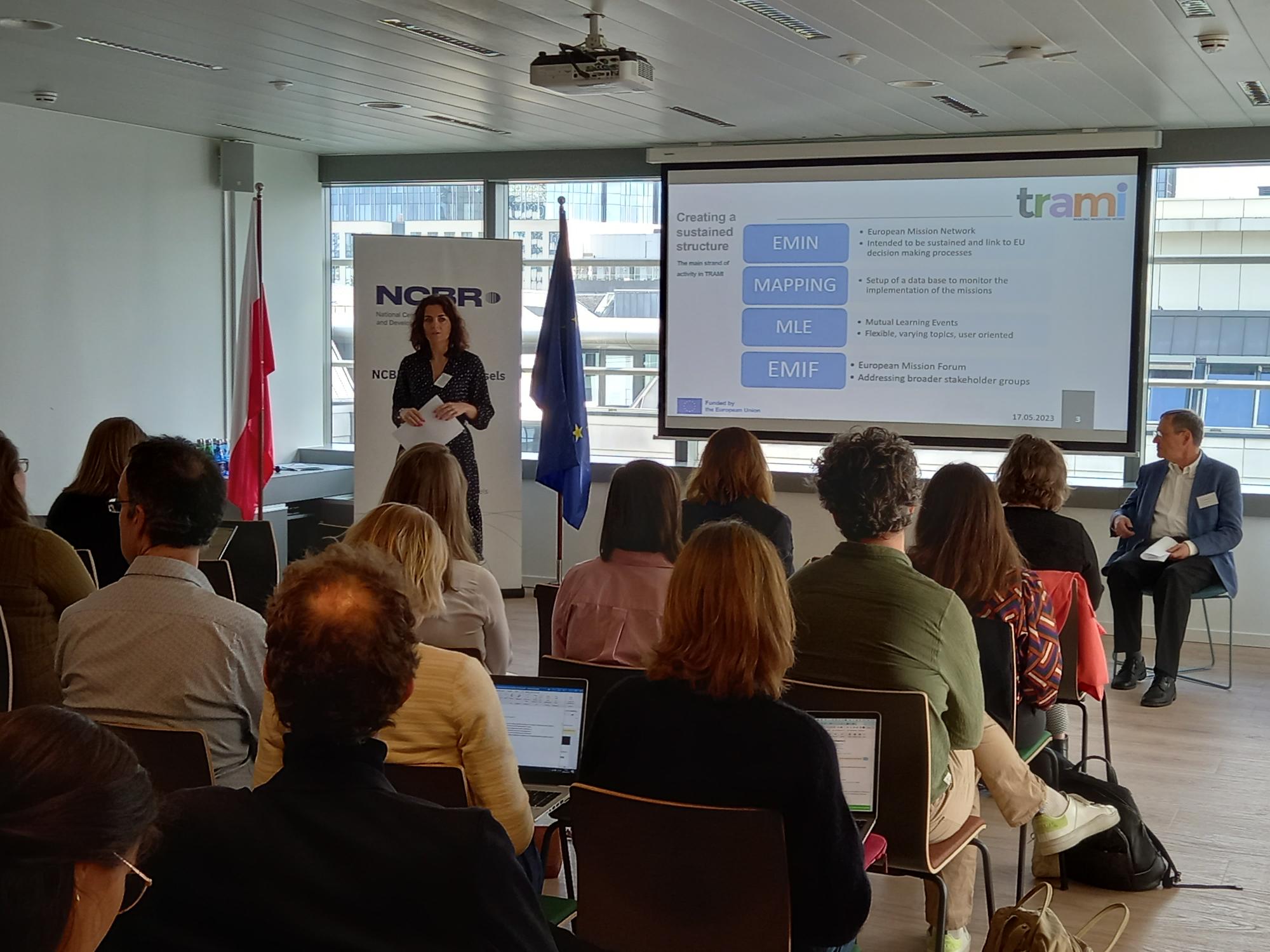Report on the fifth MLE with ERRIN
EU Missions creating new markets: the crucial role of the triple helix collaboration
ORGANISERS: TRAMI (WP3) and ERRIN
VENUE: NCBR Brussels Office, Rue Belliard 40, 1040 Brussels, 5th Floor
DATE: 17 May 2023
Introduction
TRAMI in collaboration with ERRIN ran a Mutual learning event (MLE) to explore the role of industry, academia and public authorities in achieving the objectives of the five EU missions through triple helix collaboration. MLEs are an opportunity to share experiences, learn from other stakeholders in different regions and countries.
Objectives of event
The objective was to provide an opportunity to explore the triple helix approach of collaboration efforts of industry, academics and public authorities, in the context of the implementation of the 5 EU missions. It enabled different stakeholders to share best practices and understand the opportunities and challenges involved.
Attendees
In collaboration with ERRIN, the event gathered approx. 40 attendees, this included representatives of regional offices, public authorities, representatives of academic organisation and university alliances, along with organisations representing businesses and government agencies.
Methodology
An overview of the TRAMI project, and its objectives was provided by Wolfgang Polt from Joanneum Research and Ewa Kocińska-Lange from National Centre for Research and Development Poland.
Following the overview presentations, Pirita Lindholm, ERRIN introduced a number of speakers.
- Lina Konstantinopoulou, Policy Director, Eurochambres, pointed out that sprawling climate legislations does not leave much space for extra engagement in additional initiatives like missions.
- Olga Wessels, Head of Brussels' Office at ECIU, highlighted the model of collaboration between local universities and their local partners, in particular in the cities or regions involved in the missions.
- Wim de Kinderen, Programme Director European Affairs, Brainport Eindhoven, presented Eindhoven as a very particular case of a business-driven city.
- Klaas de Boer, Research, Science, Education and Health Policy Officer, Hanse, outlined the advantages of collaboration with a crucial local actor, the Port of Hamburg.
Following the presentations, the participants were selectively divided into four breakout groups to address a number of key questions (see appendix1). The participants in the groups were preselected to endeavour to ensure a balance between all stakeholders. Please find below a combined summary of the outputs of the groups.
Summary of outputs of breakout groups
The participants addressed a series of questions and below is a summary of their comments.
What EU Missions are you interested in and how do you expect to contribute to their implementation?
- The level of interest and involvement differed across the participants, many participants were interested in all 5 missions e.g., EUS4EU, while others were interested in Climate, Cities and Oceans, with one focused exclusively on the cancer mission. Some cities were also interested in soil, cities and the adaptation mission.
- Participants discussed contributing to the implementations of the mission for example in demonstration sites, broadening knowledge, rising awareness. Universities are well connected to business generally. Pilots and demos are seen as a good entry point at regional level for businesses. Some participants were struggling to build awareness in their areas.
- There were suggestions to explore synergies with the HE funding, which is aligned with EC policy. Also Living labs and INTERREG should be considered.
- Questions were raised as to how you successfully integrate citizens and the business community.
Do you/your organization collaborate with public sector/business/academia in areas related to the EU Missions? How and with whom do you collaborate?
- Collaboration between the public sector/ business /academia can differ across stakeholders and countries. While the focus of this MLE was the triple helix, the discussions often focused on the quadruple helix of including citizen engagement.
- Many universities are well connected with business and they are reaching out or plan to reach out to a broader group of stakeholders and this can be a difficult endeavour. While other universities are at an early age in this process.
- Collaboration is taking place between participants and other stakeholders through a number of existing initiatives. For example, Eurochambres has a Memorandum of Understanding with the Committee of the Regions for jointly producing policies. Additionally, Eurochambres collaborates with regions at the business level through Digital Innovation Hubs. The NetZeroAcademy will also play a vital role in combining the existing knowledge, harmonising content for classes/lectures. The Pact for Skills (DG EMPL) facilitates a triple helix collaboration. Eurochambers is involved in the Pact for Skills related to the tourism ecosystem. And the city of Groningen developed a network between academia, public sector and industry to provide knowledge and innovation around the green transition of the textile sector.
- Other examples of collaboration include Aarhus collaborates with the University on CCC (cities mission) on a workshop; NCBR: R&I funding by pre-commercial procurement (different green deal projects, researchers are involved both in defining the challenge and solving the problem); Hamburg: collaboration with the port, the crucial player having overall positive approach for decarbonization and hydrogen. Such a collaboration (city-port) gives the city and the EC the perspective of the port. RDA: a collaboration with academia and textile industry (co-organization of common events and initiatives).
Which are the greatest challenges/ obstacles for such collaboration?
- There are many challenges at varying levels. At a high level it can be challenging getting an overview, seeing the bigger picture, the mission labels, often mission activities are not labelled as such and are not recognised, but are aligned with the objectives of the missions. There can be slow uptake of missions at national level in some countries. It is important to have political commitment, considering both long-term and short-to-medium-term perspectives. Communication can also be an issue.
- A big challenge is the required change in mind-set, behavioural change, change that will involve mobilizing citizens and businesses. There can be difficulty in achieving quadruple helix collaboration, particularly in engaging citizens and NGOs, as it may not align with the natural working style of some stakeholders (e.g. ‘traditional universities’).
- Industry involvement can be a challenge – many SMEs don’t have a strategy, or awareness and resources, and there are scarce big companies that could contribute; many partners (including the public institutions) don’t see the benefits. Businesses face challenges related to critical raw materials, energy, and skilled workers, which are not directly addressed by the Missions. Insufficient investment, as many businesses are focused on survival rather than investment. Companies need to have visibility on what their return on investment is.
- There is a mismatch between EC ambitions, and HE budget, the EC expectations are growing and some researchers from HE pillar II claim that missions should not be there, since they consume some money from the regular calls. There is also a shared opinion the EC overestimates the role of workshops, networking, etc.
- Other challenges include - limited capacities and resources, lack of interest of some stakeholders, divergent targets.
What are the benefits?
- Benefits include having steering groups, who can take up partners’ messages, having a structured outreach. Everybody wins. Innovation at the regional level and silos start working together.
- Success factors can include having a local / regional approach with concrete goals, facilitated by local authorities. Getting the right people together who have the right skills with the right timeframes.
Can you provide some examples of successful collaborations between academia, industry and the public sector (at least bilateral cross-sectoral cooperation) in achieving shared goals, and what lessons can we learn from them that could be applied to the implementation of the EU missions?
- Examples of collaborations are outlined under question 2 above.
- Mission implementation is (often) working at the regional level, however it often lacks the mission label. For example - working within a district, real local perspective (e.g. green roof on bus stops). Steering groups and structured outreach in areas. Regional/local climate adaptation action plans area coordinated effort between all parties.
What specific skills, resources and/or perspectives can your industry / public sector organisation/ academy bring to the table to implement the EU Missions to foster the triple helix collaboration?
- Wider approach beyond Horizon Europe: the portfolio approach needs different funding sources, beyond the R&I funding programme and for funding to be aligned.
- International outreach (i.e. partners), intrinsic passion and motivation, advocacy networking, facilitation, experience, networking skills, best practices and good management.
- Importance of education and vocational training, beyond R&D and support in creating new business models. Support for businesses in meeting sustainability requirements.
- Increased cooperation with citizens: quadruple helix collaboration, charters are important and visible.
- Public procurement, especially in the Cities Mission is imperative.
What kind of information, support and/or resources do you need and from whom, to effectively contribute to the success of the EU Missions?
- Active involvement from the others and an integrated outreach.
- Clear and focused communication on the benefits of missions for all stakeholders, citizens, business, academia, and government. Get the balance right in communicating – too much general information and the need for more focused target information on processes, good practices etc.
- A clear statement from the EC on how to process with the missions, it would support local/regional implementation process.
- Funding – from both EC and the national governments (some national missions happen to be a competition to European ones).
Appendix 1
Questions
- What EU Missions are you interested in and how do you expect to contribute to their implementation?
- Do you/your organization collaborate with public sector/business/academia in areas related to the EU Missions? How and with whom do you collaborate?
- Which are the greatest challenges/ obstacles for such collaboration? What are the benefits?
- Can you provide some examples of successful collaborations between academia, industry and the public sector (at least bilateral cross-sectoral cooperation) in achieving shared goals, and what lessons can we learn from them that could be applied to the implementation of the EU missions?
- What specific skills, resources and/or perspectives can your industry / public sector organisation/ academy bring to the table to implement the EU Missions to foster the triple helix collaboration?
- What kind of information, support and/or resources do you need and from whom, to effectively contribute to the success of the EU Missions?
- Log in to post comments



